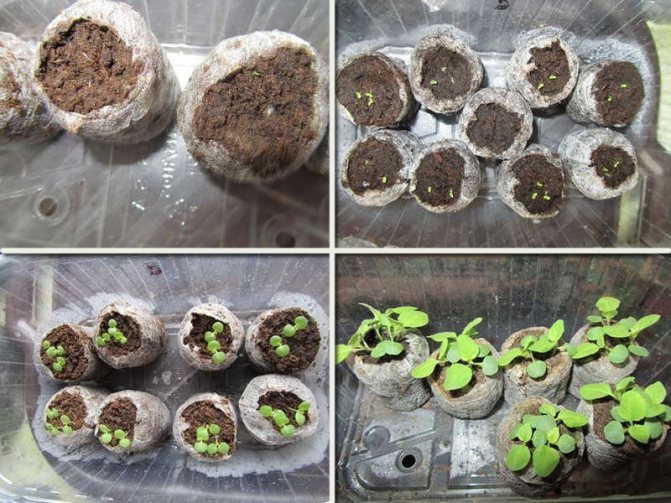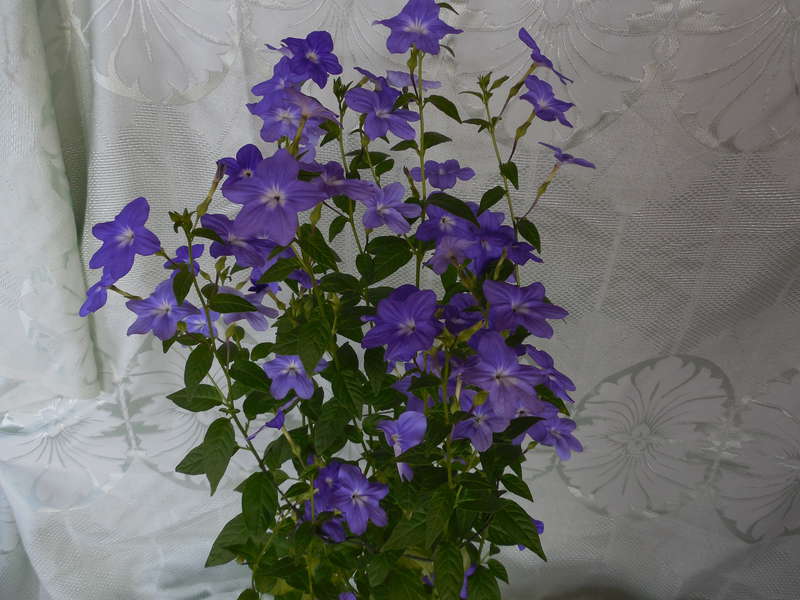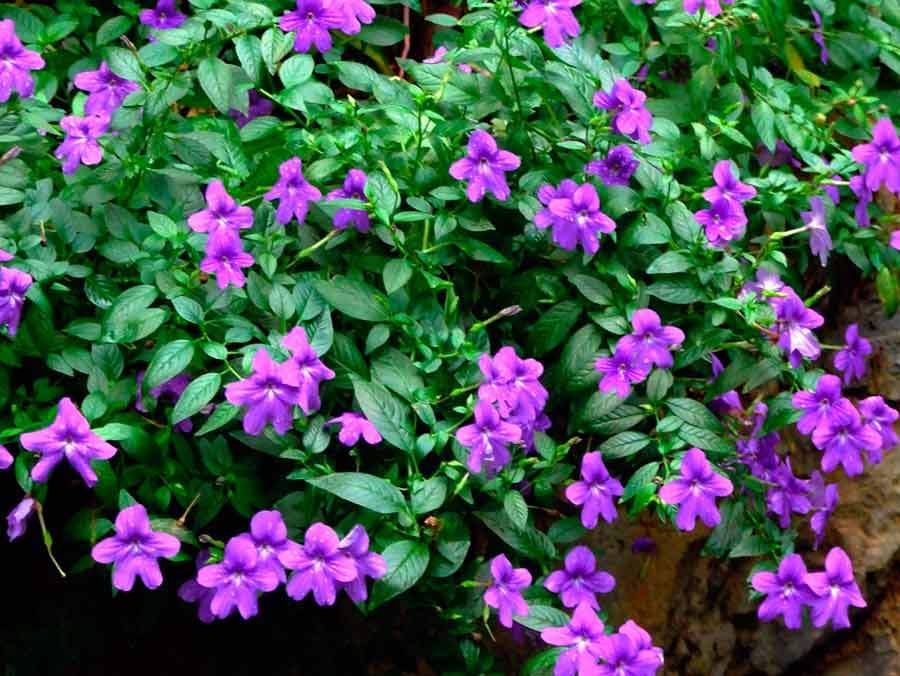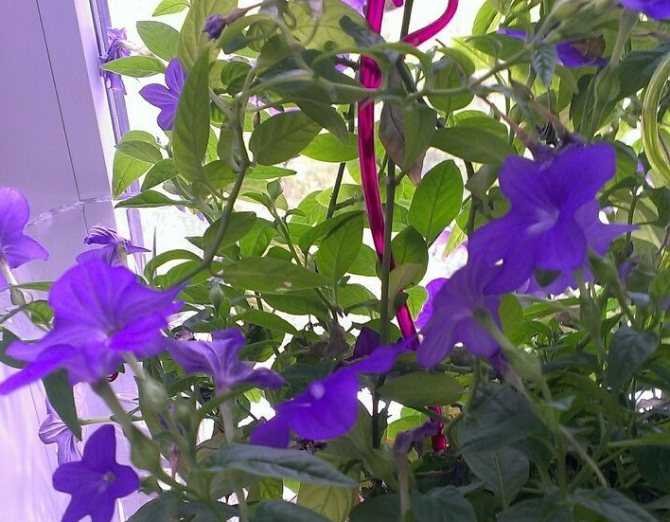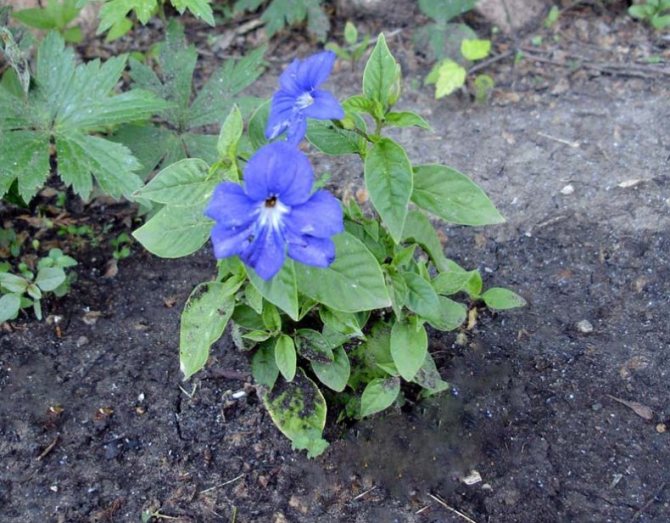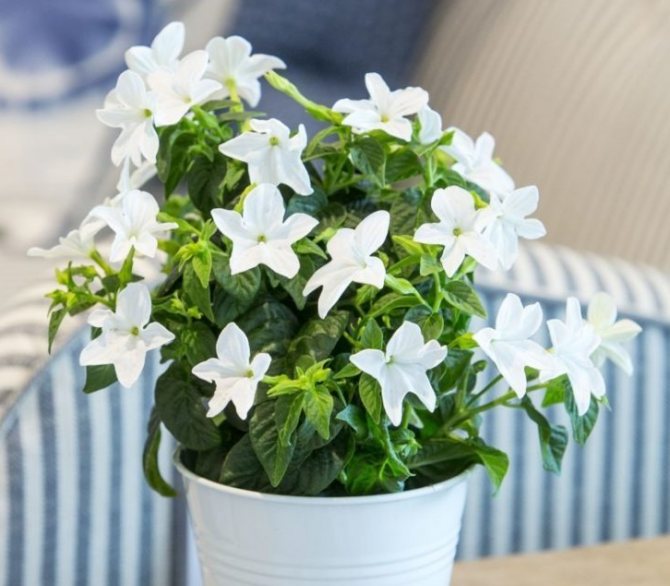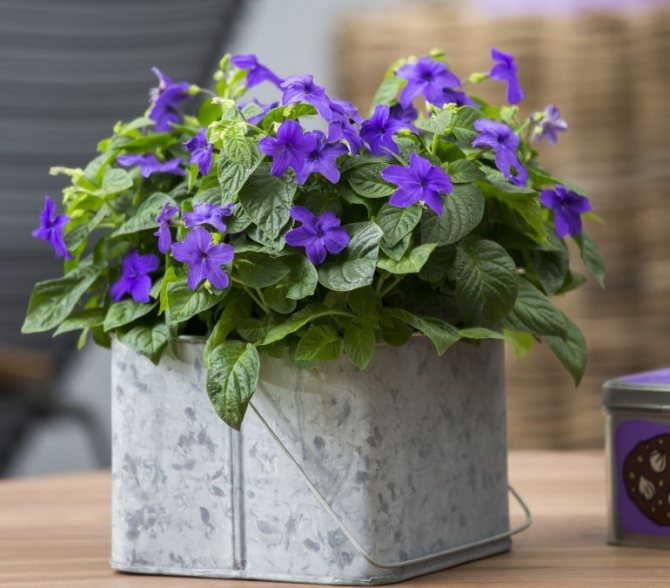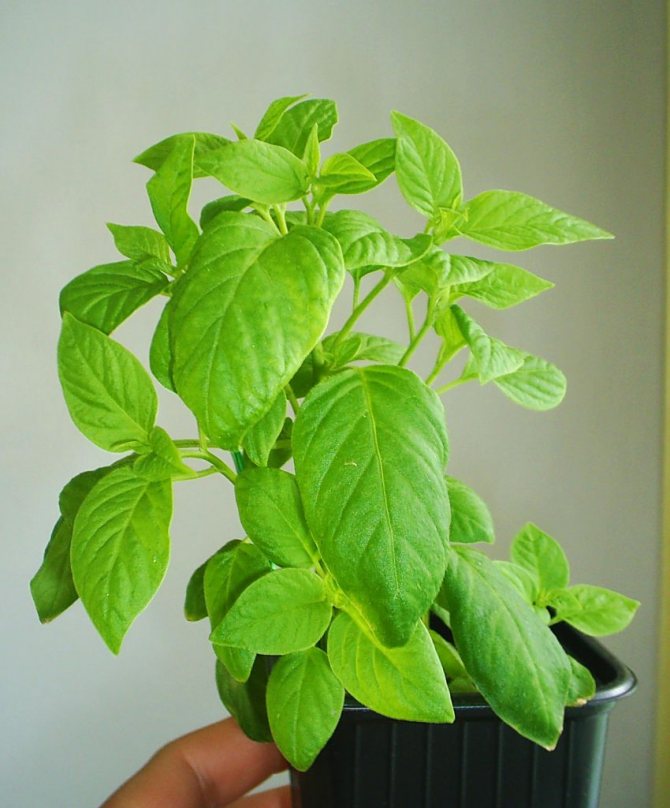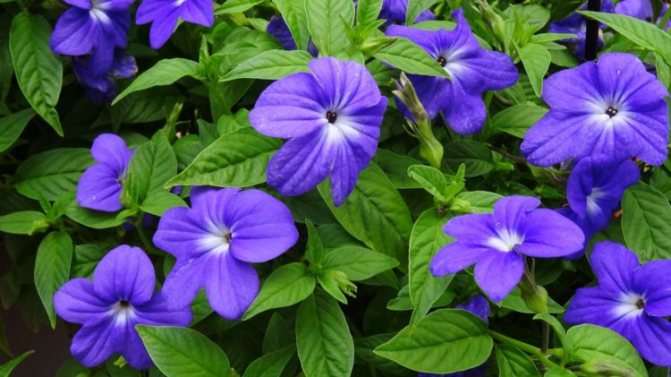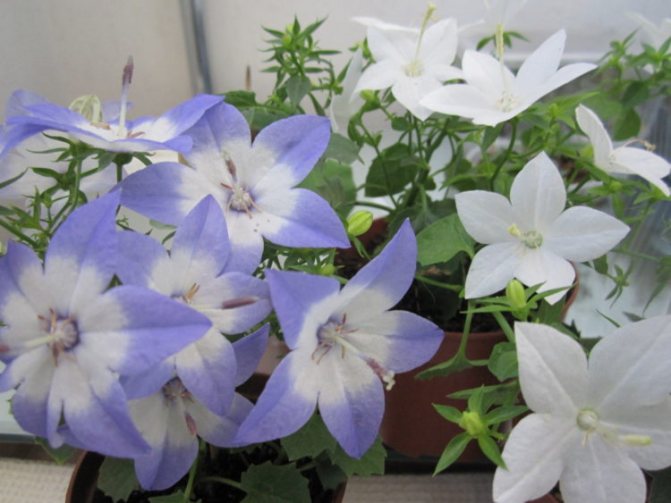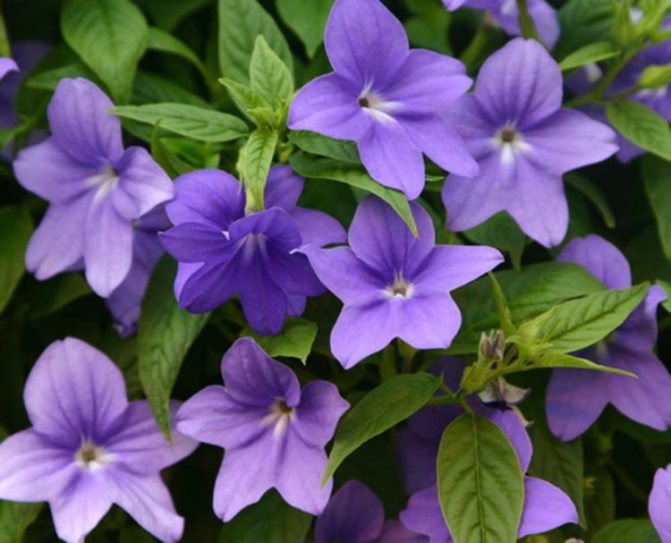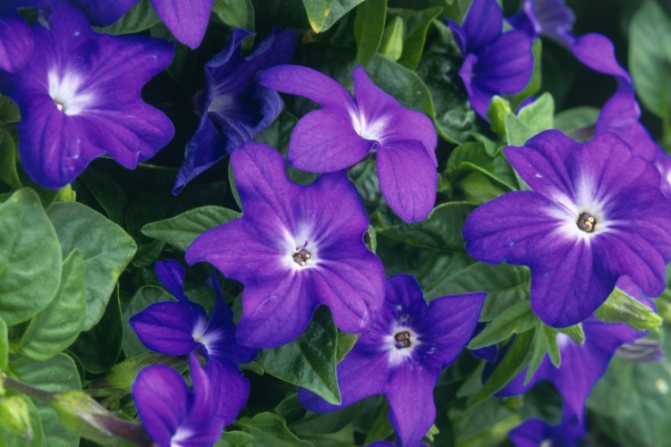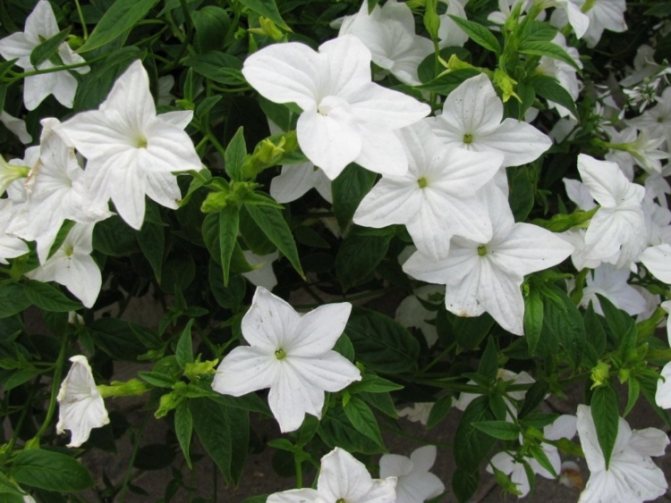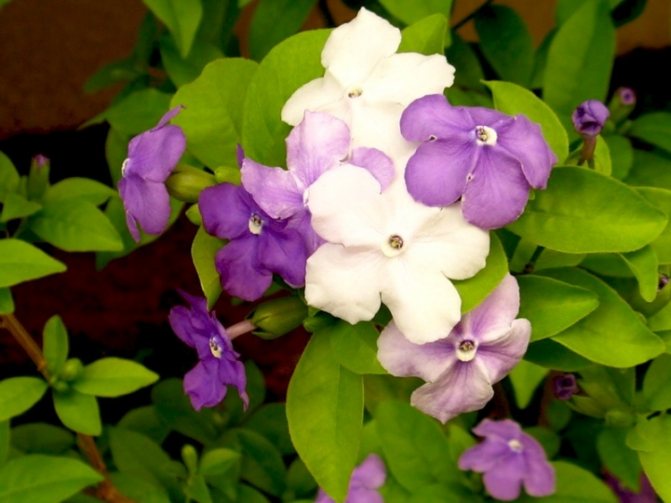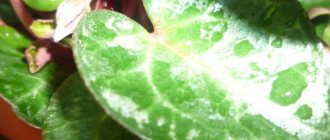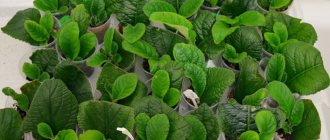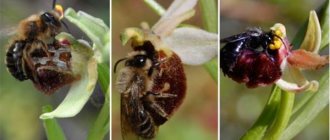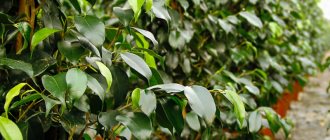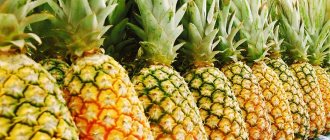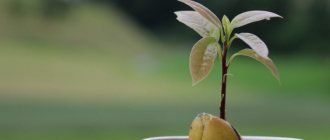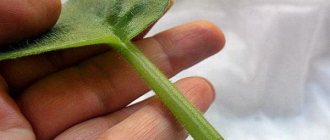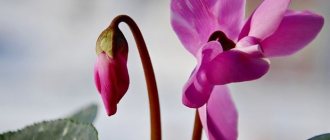Brovallia is a genus of flower that belongs to the Solanaceae family. It includes six different types of perennial plants. These flowers are found in the Southern Continent of America. This plant has both an erect stem and can be creeping. The stems are small in diameter and slightly covered with fluffy hairs. Sometimes there are bare stems, then in this case the plant forms a lot of additional stems. The stem of an adult plant can even grow up to 1 meter in length, the leaves have an even edge and a short petiole, and also resembles the shape of a heart. The length of one leaf can be either 2 cm or 9 cm. The width of the leaf plate reaches 4 cm. The veins can be seen very clearly here. From above, the leaf plate does not look very even.
Ceaseless blooming brovallias
Brovallia (browallia) is today considered to be a "new" generation of summer visitors. Of course, this plant began to be used in ornamental gardening a long time ago, but here this shy woman was practically unknown a decade ago. Combining the career of a garden and indoor plant, brovallia rightfully claims to be the most spectacular and pretty summer. Her modesty captivates more than the most exotic inflorescences of competitors.
In height, the brovallia bushes will not exceed 30 cm. This is a low-growing summer plant, which is modest in height to form very neat, perfectly rounded bushes, which seem to be created in order to show off in a pot culture. As a matter of fact, brovallia can be grown not only as a container plant: it will show off in open soil with the right selection of conditions. But the pot culture is the safest option. And blooming in a closed ground near brovallia will be the most beautiful.
Brovallia leaves are of classic oval-pointed shape, color is always rich and herbaceous. Brovallia flowers appear to be a hybrid of violets and periwinkle. Funnel-shaped, with a five-petal limb, they bloom in the axils of the leaves one by one and glow brightly against the background of lush greenery. Pretty and graceful flowers seem to be butterflies perched on bushes. And the charm of the flowers is only added by small light specks in the center of the flower, similar to eyes.
Brovallia blooms tirelessly, but only from the middle of summer. Its parade begins in July, but it really lasts until severe frosts. This summer man was one of the last to leave the garden stage.
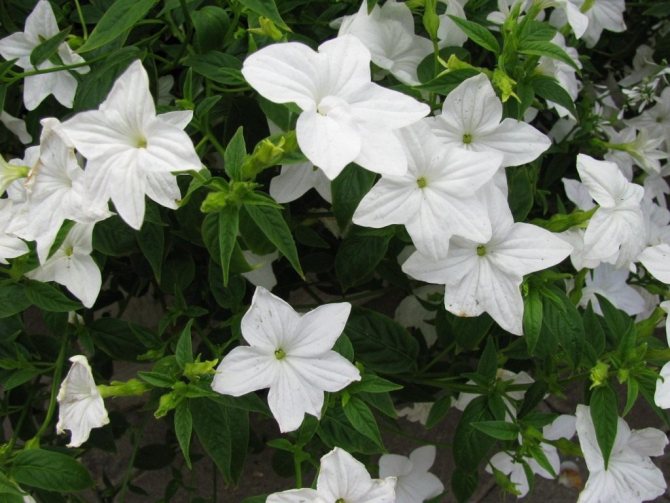
Brovallia hybrid 'Endless Flirtation'.
Be careful, the plant is poisonous! Brovallia belongs to the most dangerous garden flyers. It is a poisonous plant and skin contact should be avoided. You can work with the plant only with gloves, and even when using them, be sure to wash your hands thoroughly after working with brovallia.
Diseases and pests, treatment and prevention
Proper care helps keep the plant in shape. A weakened flower is more often exposed to diseases and an invasion of harmful insects.
Diseases and pests characteristic of brovallia - table
| Diseases and pests | Symptoms | Treatment measures | Prophylaxis |
| Powdery mildew | Stems, leaves and flowers are coated with a white, flour-like coating that can be easily rubbed off with your fingers. Further, the leaves will begin to darken, dry and fall off. |
|
|
| Aphid | On the back of the leaf, a whole colony of aphids can be located, which feeds on the sap of the plant. The leaf of the flower is deformed, its color changes and the plant slowly dies. | The following drugs are used for pest control: Intavir, Octara, Fozalon. One of the insecticides is diluted according to the instructions and the affected plant is treated. If after the first treatment there is a need for a second one, then it is better to change the drug to one of the indicated ones. |
|
| Whitefly | It hides on the underside of the sheet, so it is often invisible at first. Insect larvae suck sap from the plant, disrupting its photosynthesis, the leaf ceases to be supplied with oxygen and dies. |
| |
| Spider mite | Braids young shoots and buds with a cobweb. It punctures the leaf and feeds on cell sap. At the puncture sites, spots appear, which eventually creep and the leaf dries up. |
| |
| Mealybug | Covered with a waxy bloom, similar to cotton wool lumps, shoots are a sign of a mealybug attack. Sucking out the juice, it simultaneously injects a poisonous substance into the plant, which weakens the flower, making it vulnerable to disease. |
How to recognize diseases and pests - photo gallery
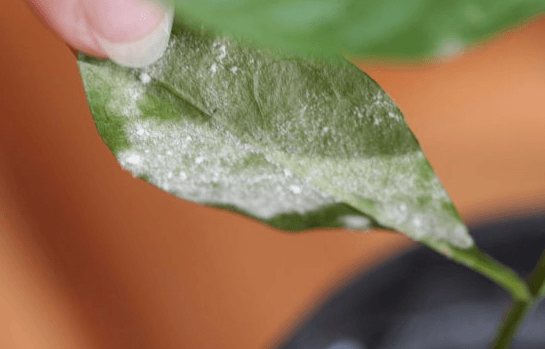

Powdery mildew appears at high humidity and high air temperatures
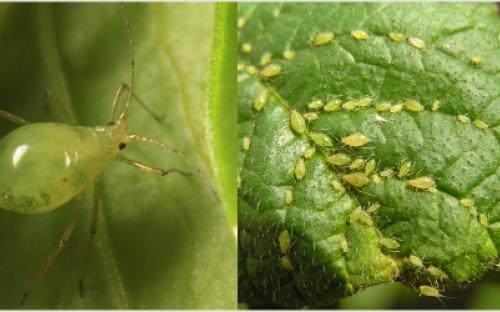

Aphids settle in whole colonies on the inside of the leaf.
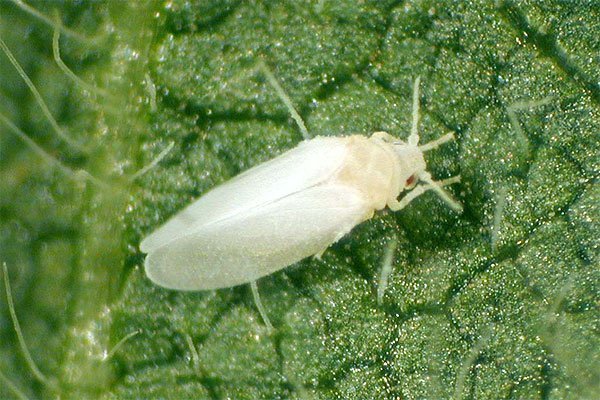

Not the whitefly itself is dangerous, but its larvae


Spider mites like to feed on plant sap


Mealybug injects toxic substances into the leaves of the flower
Variety of brovallias
This summer is not the most representative in terms of varieties and types. In the genus brovallia, only 7 plants are combined, while only 2 brovallia are used in horticulture. Erect and densely branched, they are generally similar to each other. But there are still species differences.
Brovallia is beautiful (Browallia speciosa) - entering into bloom from the middle of summer and lasting until the very frost, Beautiful Brovallia is abundantly covered with small flowers up to 5 cm in diameter. Blue, lilac, blue, violet and dark purple, sometimes white, often with a white eye in the center or lighter colored outside than inside, abundantly cover the bush so that under them you can hardly see slightly pubescent leaves with thin tips, forming spreading spheres in diameter up to 60 cm.
American brovallia (Browallia Americana) produces small flowers, but in such quantity that they easily cover the greenery of the bush. Only about 2 cm in diameter, white or purple-blue flowers abundantly cover compact, dense bushes.Outwardly, this beauty is easy to confuse with sticky brovallia, but her shoots are not sticky, and the greens are somewhat darker.
Earlier, Brovallia sticky and Large-flowered Brovallia were distinguished separately as independent species. Currently, both species are combined into Browallia Americana and are synonymous with it. In the literature, you can still find a description of these species as independent, which is not entirely true.
Brovallia sticky (Browallia viscosa) is a highly branched summer plant up to 30 cm high with an amazingly lush bush-sphere of greenery. The flowers rise above the leaves, dark blue or periwinkle blue, in some varieties - white, seem large for such a compact plant. This brovallia got its name for sticky shoots, but this property does not burden the care of the plant. The best varieties of viscose brovallia today are considered "Alba" with snow-white funnels of flowers with a yellow eye and sapphire blue "Sapphire" only 20 cm high, but with a large number of flowers on the bush.
Brovallia grandiflorum (Browallia grandiflora) - the species with the most sprawling, wide and powerful bushes, which in comfortable conditions can reach half a meter in height. White or blue flowers are not single, but are collected in loose clusters of inflorescences. This brovallia looks somewhat sloppy, but due to the more massive inflorescences it seems brighter than its competitors.
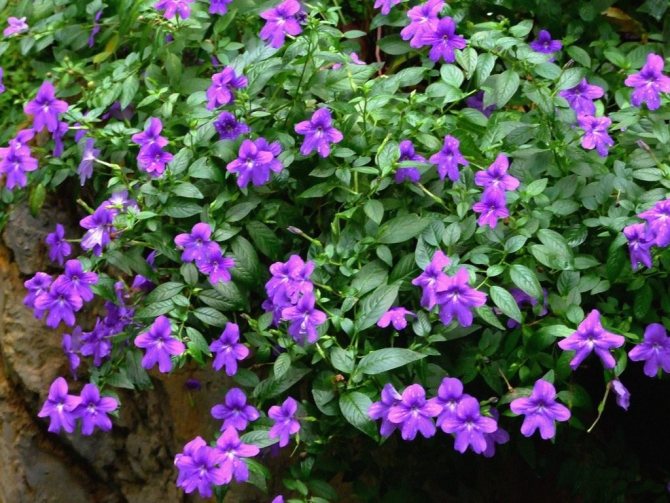

Brovallia beautiful (Browallia speciosa).
Brovallia in garden design is used as:
- crops to create bright, richly colored borders;
- decoration of the foreground of flower beds;
- beautiful spots and small landscape groups on the lawn and meadows of ground cover;
- one of the best summer season for landscape design;
- a bright spot and accent on flower beds and in flower beds;
- an accent in flower beds for summer gardens;
- a beautiful summertime for compositions in street pots, stone flower girls;
- one of the brightest soloists for balconies and terraces;
- unusual ampel and decoration of the edge of tall tubs, rootstock for trees and shrubs in containers (brovallia has flexible shoots, which, although not in a cascade, but very effectively hang from the edge of the containers).
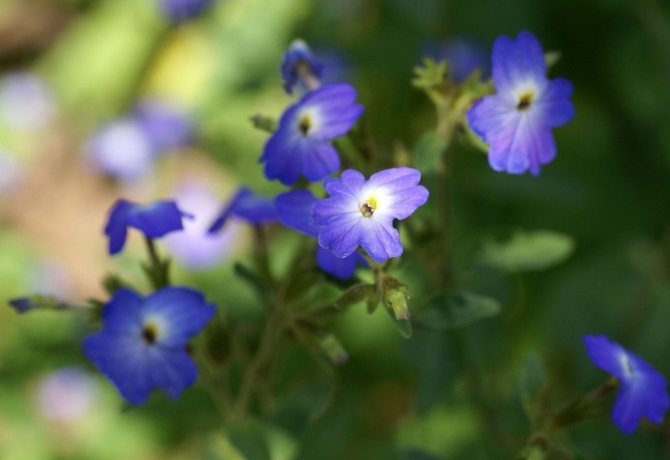

American Brovallia (Browallia Americana). <>
Types of eyebrow
A favorite among indoor plants is a type of brovallia called brovallia. Beautiful... If you describe a plant, then it will be a low herbaceous bush that does not exceed 70 cm in height in the wild.
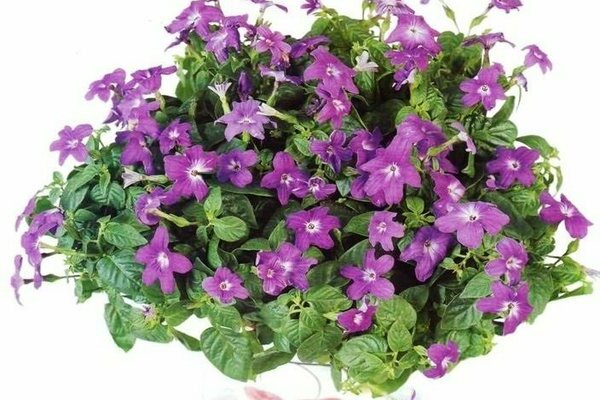

Brovallia Beautiful: photo
At home growing, the brovallia flower will be less than half a meter. The stems here will be normal, bare. On the leaf blades, you can see small fluffy villi that are located near the prominent veins. The leaves themselves are about 5 cm long. They are egg-shaped with a slightly pointed tip.
The shape of the petals resembles the shape of leaves, but they are somewhat wider. The shade of flowers here is very delicate, purple with blue notes. Inside, the flower has a white tint and bright contrasting yellow stamens that stand out against its background. Flowering lasts a very long time, especially if the plant is in comfortable conditions for it. Thus, the flower can be pleasing to the eye all year round.
Among the popular cultivars for growing eyebrows at home, there are White Bells with dazzling white flowers, Jingle Bells, where the flowers have a very bright blue tint, and Blue Bells with blue inflorescences. The select also includes such a variety as Blue Troll. Here the shade of the flowers will also be blue.
Brovallia flower pubescent
The following species of this brovallia looks very nice - Pubescent... Perhaps, at the present time it is not in such demand, but it has great prerequisites for this.


Photo of pubescent brovallia
A compact shrub that does not exceed 70 cm in height and has felt shoots. The leaves are in the shape of a wide heart, about 5 cm long. The flowers are very small, delicate, beautiful. The shape of the petal resembles a heart, and in the middle there is a pronounced groove. The shade of the petals can be blue, blue, purple. In general, it can be different. The inflorescence itself does not exceed one and a half centimeters in diameter.
You can also say separately about such a species as brovallia Sticky... The characteristic name describes its peculiarity, as the plant has sticky stems. The plant does not exceed 20 cm in height and during the flowering period forms a cap, consisting of small, sapphire-colored inflorescences. Under favorable conditions, the flowering period lasts about 4 months during the winter period.
Choosing a soil for brovallia
This summer is quite picky about the ground. Brovallia can be planted in open soil only in infertile, but high-quality, drained soil. It will not survive in dense and too wet soils. Excessive nutritional value leads to the rapid development of greenery to the detriment of flowering, but medium-fertile brovallia garden soil is fine. But for a container culture, it is enough to choose a universal substrate or soil mixture for flowering plants.
Brovallia feels very good in the soil, consisting of equal parts of sand, sod soil, humus and leafy soil.
How to grow an indoor flower
Brovallia does not need a transplant, since its life span is short - a maximum of 2 years. After flowering, the plant begins to age and dies after the seeds ripen. But such a short period of time is not an obstacle for cultivation by cuttings or with the help of seeds.
There is no point in replanting a purchased flowering plant. In the future, rejuvenating or propagating a plant, it is imperative to use a suitable soil for it.
Planting pot
Choose a pot made of plastic and always with drainage holes. Brovallia is often used as an ampelous plant and is grown in hanging containers.
You can use supports or ladders that are fixed in a pot with a plant.
When deciding on the size, keep in mind that a wide pot is needed for the brovallia. Choose the depth, taking into account the drainage layer of about 5 cm, which will prevent the accumulation of liquid in the roots and protect the plant from rot.
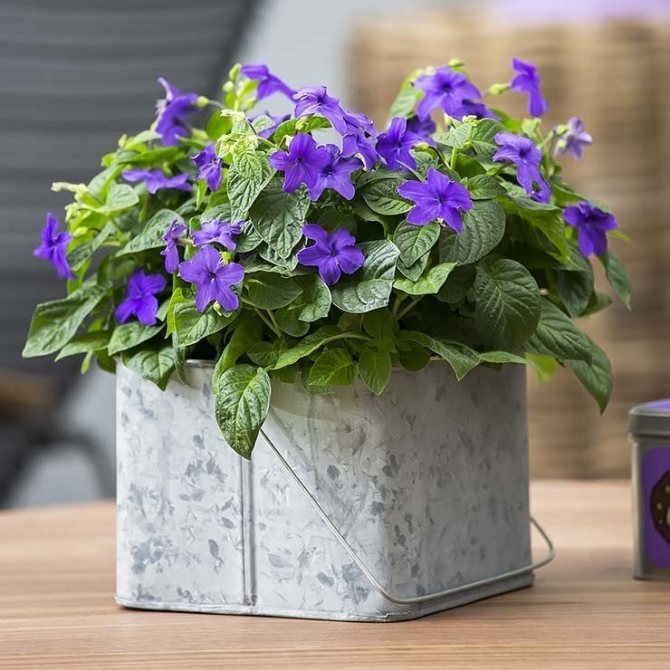

To make the brovallia even more decorative, the pot with it can be put in an unusual planter
Substrate
Brovallia grows equally well in universal commercial flowering soil and in simple garden soil. You can also prepare a substrate for it, consisting of the following ingredients taken in equal parts:
- sod land;
- leafy land;
- humus;
- sand.
The substrate, prepared independently, or the soil taken from the garden must be disinfected.
Features of care for brovallia
The most time consuming component of caring for this summer is watering. Both in the room, and in the garden pot, culture, and in the open field, it is necessary to maintain a stable soil moisture. Watering for this plant should be systematic, regular. The procedures are adjusted according to the weather, but the main task is not to overmoisten the soil, to constantly maintain it in a slightly moist state. It is better to carry out deep soil impregnation, rather than frequent surface watering. But never allow drought: after the soil has completely dried out, the plant withers and does not recover.
If brovallia is grown in pots, then it will not give up on regular spraying. It can be held twice a day in the summer. The flowers of the plant are not afraid of getting wet, and the foliage will only become more beautiful from an increase in air humidity.
Brovallias growing in the soil are not fed, and fertilizers are applied for potters every 2-3 weeks.It is better to use mixtures for flowering crops.
Pruning is an essential component of caring for this plant. In order for the bushes to be attractive and lush, the plant develops in the form of a neat sphere, it is necessary to shorten or pinch the elongated shoots in a timely manner. But it is better to direct the main efforts in pruning not to shaping (after all, brovallia looks attractive by nature), but to removing dry leaves, fading flowers.
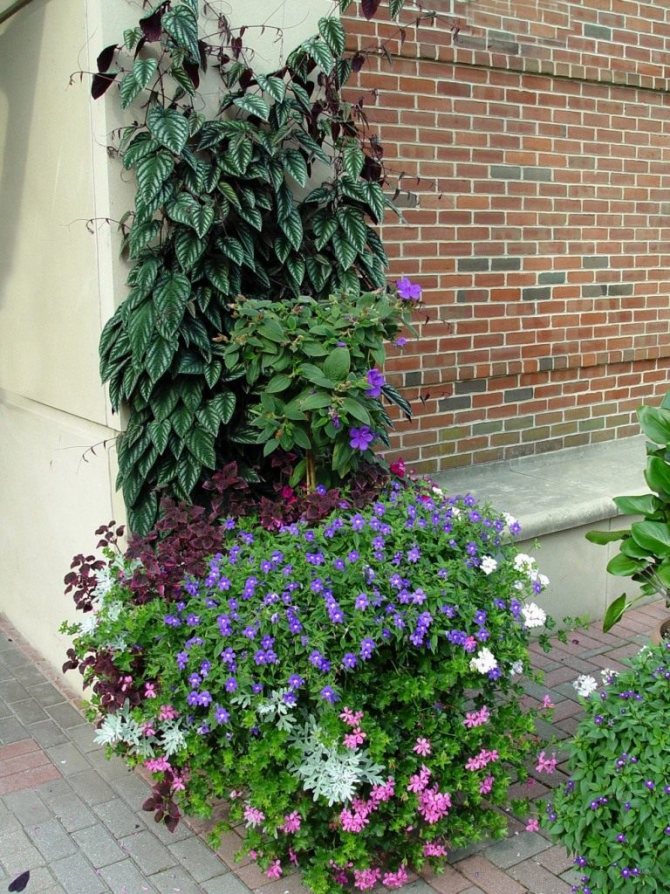

Brovallia in a mixed flower bed.
Care errors and how to fix the situation - table
| Leaving error | How does it manifest | We fix the situation |
| The leaves are covered with yellow spots | sunburn | Hide the brovallia from the midday sun. |
| Yellowing of the leaf plate | chlorosis - lack of iron | Use a balanced, universal fertilizer for flowering plants as a top dressing. |
| The plant looks frail, drooping |
|
|
| Brovallia has pale leaves | too dark room | The plant loves good lighting, provide it with a bright room. |
| Falling leaves | sharp temperature fluctuations | Change the position of the brovallia, find a place for it with a suitable temperature. |
| The number of buds laid is reduced | the room is very hot |
Continued flowering of brovallia at the end of the season
If your brovallias continue to bloom despite the approaching cold weather, and you have the opportunity to clean the brovallias in your living quarters for the winter, then this beauty does not have to be thrown away at the first cold snaps. Brovallia can really only be grown as an annual, but if you remove the containers in the room in time, then you can enjoy its flowering for a few more weeks, or even months.
In a bright, with moderate temperatures (from 15 to 18 degrees Celsius), with regular watering, brovallia will successfully complete its parade, decorating the gloomy autumn and winter interior with bursts of amethyst flowers. After flowering, it will have to be thrown away and replaced with new plants.
What does a plant look like and what are the features of its cultivation
In the wild, brovallia is common in South and Central America. The plant is presented in the form of shrubs or semi-shrubs, growing up to one and a half meters. Indoors, it forms small bushes up to 45 cm high. Its leaves are deep green and slightly pubescent, have an oval shape with a pointed tip.
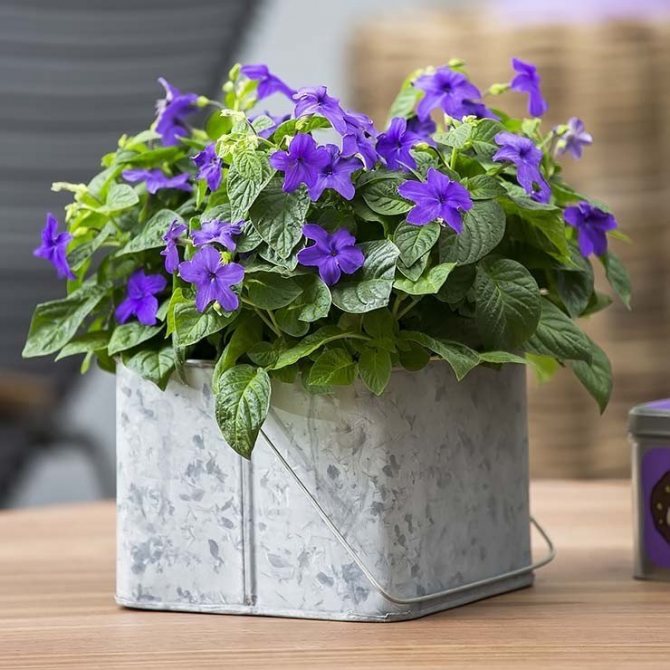

Brovallia acquires the greatest decorativeness during flowering, when many small buds are blooming. Their color varies depending on the species and can be as follows:
- purple,
- lilac,
- white,
- pink,
- blue.
The flowering period lasts about 15-17 months... Even in winter, flowers adorn the plant, but in smaller quantities, due to a lack of light. Brovallia has a life cycle of only 2 years and during this time it manages to bloom only once. After this, the plant soon dies. However, it is not that difficult to reproduce.
Seeds for breeding a new brovallia are harvested from an old bush from fruits. They are formed after flowering and are boxes with valves, when opened, small black seeds spill out. Their germination is high, so that even a novice grower will find it easy to grow a bush. In the process of growing a flower, it is recommended to pinch the stems at the tops, which enhances lateral branching. To make the bushes look lush, they are planted in several pieces in one pot.
Since the plant is poisonous, gloves are used when working with it. It is recommended to keep it out of the reach of children and pets.
Brovallia breeding methods
Seeds
Sowing seedlings can be carried out literally throughout the year, adjusting the flowering time and getting specimens that bloom even in the middle of winter for indoor culture.For a garden, brovallia is best sown in March (for open soil) and from February to May for a pot culture. The seeds must be soaked in warm water for 48 hours, after which they are rarely scattered over the surface of the sifted substrate, without covering it with earth. Do not moisten the soil before sowing, but spray it after sowing the seeds.
Germination can only take place under glass or film, which must be removed daily for ventilation. As the seedlings grow, be sure to pinch the tops, form bushes. De-picking can be done after releasing the fourth leaf. But brovallia can be transferred to soil or garden pots only after the last night frosts have disappeared, not earlier than mid-May.
Cuttings
Brovallia shoots root perfectly in any light soil under the hood, subject to constant moisture. You can cut the apical cuttings from May to the end of summer.
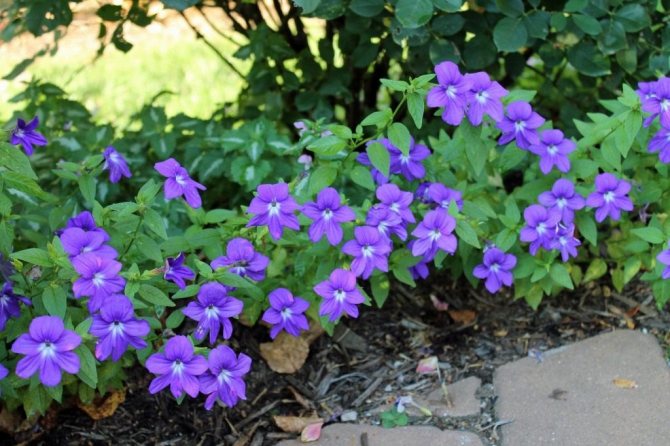

Brovallia ‘Marine Bells’.
Step-by-step breeding instructions
Since brovallia does not live long, it is necessary to periodically renew it by reproduction.... You can do this with cuttings or seeds.
Cuttings
An easy-to-use method that does not require special skills. As a result, the procedure allows the plant to be rejuvenated. Cuttings can be rooted in soil or water.
Sequencing:
- Cuttings are harvested in the spring or at the beginning of the summer season. To do this, choose strong shoots without buds and cut the tops to a length of 15–20 cm.
- They are planted in loose soil (you can buy ready-made for Saintpaulias).
- Cover the cuttings with glass or plastic caps and place them on the windowsill. To avoid direct rays, shading is created. The optimum temperature for germination is +20 ° C.
- Every day, the mini-greenhouse is slightly opened for ventilation and the substrate is moistened.
- They start picking in individual pots as soon as new roots appear on the cuttings.
Brovallia cuttings root no less successfully in water.
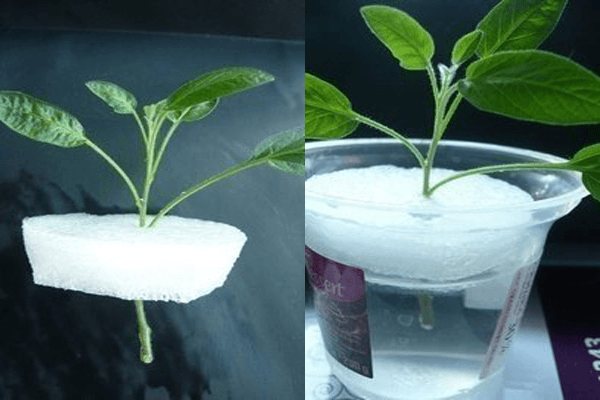

Brovallia cuttings take root quickly in water
About brovallia on a note
Brovallia is also very good as a houseplant, however, also an annual: after flowering, the plant will have to be thrown away. For it, you need to select only high-quality soil, lay drainage at the bottom of the tanks and keep it in bright rooms protected from direct sunlight with an air temperature of at least 20 degrees Celsius.
When wintering in cooler conditions (about 15 degrees Celsius), the plants will continue to bloom and delight far beyond the traditional season. Caring for brovallia in a room culture is not difficult: it will need watering, top dressing from spring to autumn and frequent spraying, supplemented by pinching shoots that are too long.
What conditions are required depending on the season - table
| Season | Lighting | Humidity | Temperature |
| Spring | The location of the brovallia should be very light, but the plant does not like direct sunlight. A western or eastern window sill will provide the flower with enough sun during sunrise and sunset. From the midday bright rays, you need to hide the brovallia behind a curtain. In summer, it will feel great on a balcony or loggia, being in diffused light. Daylight hours for flowering brovallia should be at least 12 hours. It will not bloom in the shade. | The plant does not need high humidity. But even in a room with dry air, it will feel uncomfortable. On hot days, it is recommended to spray the leaves with soft water 1 or 2 times a day. This measure will prevent buds from dropping. When moisturizing, be careful not to get water on the flowers. | The average optimum temperature for brovallia is + 20 ° C. At elevated temperatures, the plant loses its decorative effect, the leaves turn yellow and the buds cease to form. |
| Summer | |||
| Fall | In winter, they are kept in a cool room at a temperature not higher than + 17 ° С and not lower than + 15 ° С. | ||
| Winter |
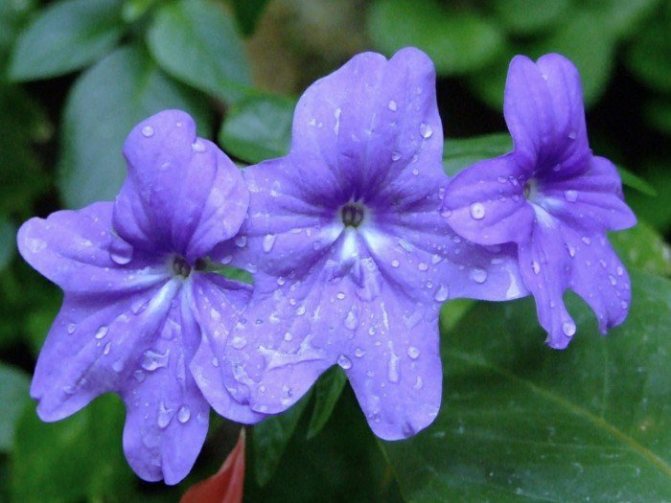

On hot days, brovallia must be sprayed
Watering and feeding
Brovallia is unpretentious, but requires systematic and abundant watering. However, it does not tolerate stagnant water and prolonged drought. Moisten the soil immediately, as soon as the surface is dry. In addition to watering, it needs sprinkling, especially in dry weather with low humidity. Spraying is best done with a fine spray, which creates the effect of water dust. In dry weather, when water gets on the flowers, ugly white spots are formed, so it is better to spray on the leaves.
The nutrients necessary for brovallia are contained in a complex mineral fertilizer for flowering indoor plants. The frequency of dressings, every 10-14 days. Supporters of organic farming use "Emochki" and other live microcultures to improve the quality of the soil.
Brovalia home care
The plant requires minimal maintenance, fully justifying the money spent on the purchase, temporarily creating a floral temporary picture in the house.
Location
The flower requires a bright, warm place and a lot of light, although it does not tolerate direct sunlight. The ideal location is the western and eastern windowsill, where there is an abundance of daylight in the morning and evening. Brovalia grows well in the south or southwestern direction, but it is recommended to provide the plant with 2-3 hours of sunlight daily. In hot midday, brovallia needs to be shaded.
Attention! The eyebrow flower does not tolerate drafts.
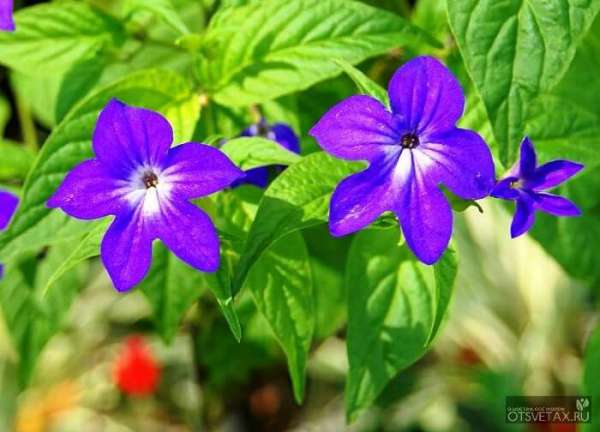

If the flower is located in the shade, then the plant will not bloom. The condition for flowering is twelve hour daylight hours. If this condition is not met, flowering will be short. You can extend daylight hours using fluorescent lamps. If there is little lighting in the room in winter, then the temperature should be lowered to 16 ° C and the plant should be allowed to rest.
Temperature
The plant is kept at t = + 22-25 ° C in summer. In winter, at a temperature not lower than 15 ° С. You should be aware that high temperature reduces the decorative effect of the plant and escorts the appearance of various pests.
How to water a browball
During the growing season, brovallia is watered abundantly, since the active growth of the flower is always accompanied by the rapid drying of the soil. During flowering, watering should ensure complete moistening of the earthen coma. We can say that watering should be plentiful in spring and summer. In winter, reduce watering and water the flower sparingly. If the plant is overdried for some reason, then it will be impossible to restore it.
Air humidity
The plant is undemanding to high humidity, and yet it will not be superfluous to occasionally spray the leaves, and regular spraying with soft water is a measure to prevent buds from dropping. In a particularly hot season, it is advisable to place a container with water next to the plant.
When spraying a plant, it is not permissible to get moisture on the flowers, since brown spots form on them from the water.
When flowering, periodic fertilizing with mineral fertilizers is required for flowering indoor plants. The interval of procedures is 12-17 days or 2 weeks. Fertilizer "Rainbow" is ideal for feeding a flower.
Attention! To make the plant more bushy, you should regularly pinch the tops of the shoots.
A good substrate for eyebrows is garden and vegetable garden soil. When using such soils, they must be carefully processed and disinfected. Tilling the soil will get rid of garden bacteria and destroy the eggs of various garden parasites. The ideal option is a ready-made soil mixture, which can be bought at flower shops. Florists often prepare the soil on their own. To do this, take:
- river sand (1 h);
- humus (1 hour);
- peat (1 h);
- soddy clay soil (2 hours).
As mentioned above, a seasonal plant does not need a transplant, but if the plant is grown as a perennial, then when the flower ages, it needs reloading. Aging usually occurs in the second year of the flower's life. It is accompanied by thinning foliage and poor flowering. For plant renewal, the material obtained by reproduction is used.
Attention! The brovalia plant is toxic and closely related to bleached and mandrake. Safety measures should be followed and protected from contact with the flower of children and animals.
About boarding and transfer
Brovallia is rarely transplanted. Usually it is grown for one season, and after the last flowers wither, they are sent to the trash. But more and more often, growers are trying to extend the life of a plant, at least up to 2-3 years. And for this, before the start of a new flowering, the brovallia is transferred, preserving the earthen coma, into a new pot.


Brovallia is transferred to fresh soil to prolong its life.
This plant is never large, so the volume of the pot should not exceed one and a half to two liters. A low capacity is not suitable for brovallia, it is better to choose a high one in order to pour a larger drainage layer. Brovallia roots will be protected from moisture stagnation by expanded clay, chips of brick or clay, vermiculite, perlite, crushed polystyrene.
The land of an ever-flowering bush needs fertile, airy and well-conductive moisture. You can plant brovallia in a universal potting soil by adding charcoal and some sand to it. Here are some compounds that the flower will like:
- equally fertile soil and compost + a little vermiculite and charcoal;
- 2 parts of sod-clay soil, 1 part each of humus, peat and coarse sand;
- 2 shares of rotted compost (humus), 1 share each - leaf earth, sand (vermiculite);
- in equal parts, the land is soddy and leafy, humus and perlite.
Brovallia shoots are not covered with bark, they are rather weak. And it is difficult for them to hold clusters of flowers, under their weight the twigs can wilt. If you are growing a bush, not an ampel plant, during planting, install a support for the stems in the pot and tie them up.
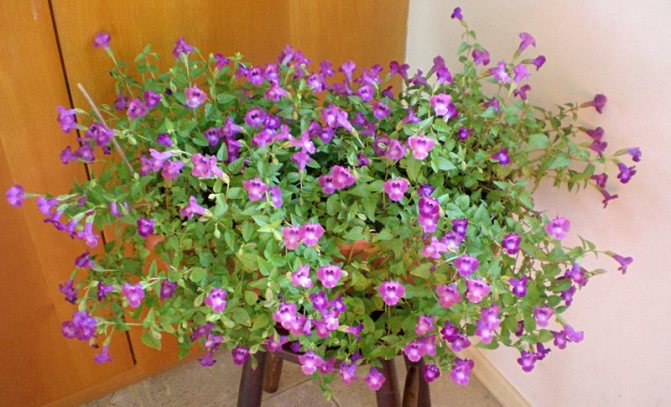

To make the brovallia look neat, you can install a support for it.
Transhipment of brovallia
- Take a suitable container with holes, place the drain on the bottom. Everything must be disinfected - steamed or at least doused with boiling water.
- Spread the sterilized primer on top. Don't tamp it too hard, it should keep it airy.
- Remove the brovallia from the old pot.
- Examine the root system. Remove softened, darkened and dry roots.
- Try not to damage healthy roots, you do not need to prune them.
- Place the earthen brovallia ball in a new pot. Add soil.
- Lightly tamp the substrate at the roots. The plant likes loose soil.
- After transplanting, cut the stems tightly, if this has not been done before, water the flower with warm water, spray it.
- Place the transplanted brovallia in its permanent place.
Do not transplant flowering brovallia. Wait until the end of flowering, otherwise you risk losing not only the buds, but the entire plant. He will not have enough strength at the same time for flowering and adaptation after transplantation.
Recent Entries
Rose Petal Jam and Its 7 Health Benefits You Likely Didn't Know About What Fruit Are You According to the Zodiac Sign The 11 Best Grape Varieties That Will Help You Create Unique Homemade Wine
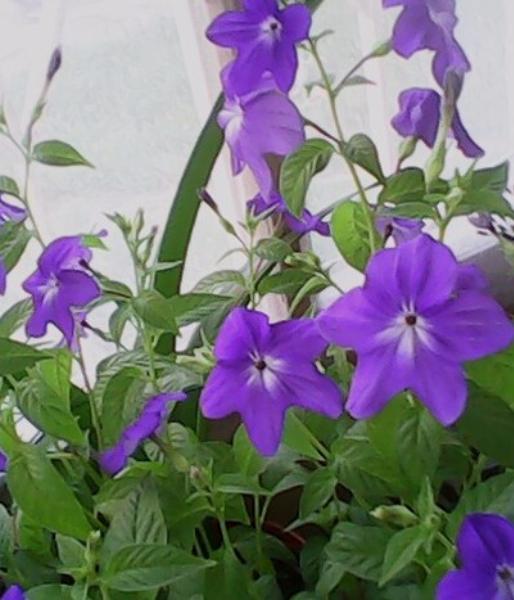

Do not transplant a flowering brovallia bush.
Photo
Next, you can see the photo of this flower:
Application in design
Most often, brovallia is used as a solo plant, placing the necessary accents in the interior, for example, decorating a coffee or kitchen table.
It is rarely found in flower compositions. In the garden, it can be found on flower beds and borders, as well as in containers on balconies and verandas. It can also grow as an ampelous plant.
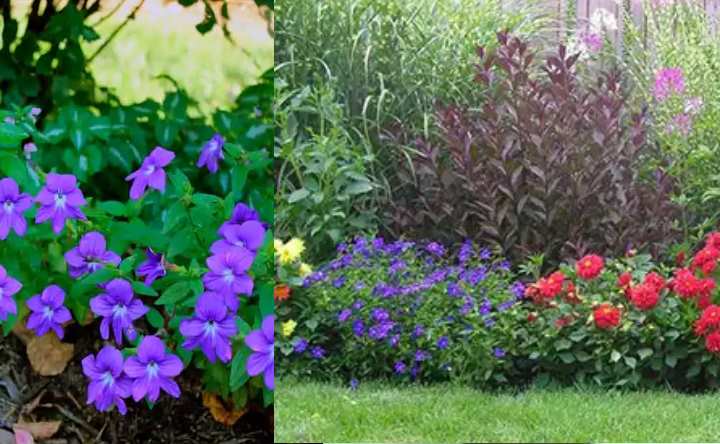

As you can see, brovallia is not as difficult to care for as it might seem at first glance at this exquisite and aristocratic flower.
Everyone can cultivate such beauty. And for more than 1.5 years, you will be able to admire the ever-flowering plant.
What difficulties can be when growing Brovali
Brovallia is a shrub that is practically not exposed to diseases and pests. For the health of the plant, you need to follow the rules for caring for it. If the bush began to turn yellow and wither, it means that it is cold and the situation can be corrected by moving it to a warm place.
If the plant is over-watered and the room is damp, powdery mildew will appear. It is easier to throw away the affected plant, it is useless to treat an annual. Keep an eye on the humidity and watering regime, there will be no problems with growing shrubs.
Another pest that can be dangerous for a plant is a spider mite. You can get rid of it with the help of chemicals that are sold in every flower or country-themed store.
Sometimes the plant develops chlorosis. For the most part, Brovallia grows well at home and pleases with flowers almost all year round. If there is a place for her on your windowsill, the winter garden will be replenished with a delicate and bright beauty.
Flower reproduction methods
Cuttings
Cuttings are taken from an adult plant in spring or summer. They should not have buds, then rooting will be better. After cutting, root the cuttings in a nutritious soil, and as soon as the roots are formed, then make a pick, planting the plant in pots and pinch the tops. Then the culture will be more lush and bushy.
Seeds
Collect them after ripening, and plant in late February and early March. To bloom in the spring, sow the planting material at the end of winter. Procedure:
- Prepare a box, pour a nutritious composition into it, which you can prepare yourself according to the above recipe.
- Scatter seeds on top, deepening them slightly.
- Spray the soil and cover everything with glass, which is open every day for ventilation.
- Seedlings are formed in 7-10 days. The glass can now be completely removed. At this time, the culture needs moderate watering and a long day of light.
- As soon as 2-3 leaves are formed, make a pick.
Read more about the cultivation and reproduction of brovallia from seeds and cuttings here.
What are the varieties of Brovaliy?
In the conditions of a city apartment or house, several types of flowers can successfully grow. As mentioned above, the most popular Brovallia variety is beautiful. This plant has the shape of a small bush, in nature it grows very large, up to 70 centimeters in length, the width depends on the availability of free space.
Under artificially created conditions, the plant does not grow so much, its maximum height is up to 40 centimeters. The flower leaves are dark green in color, up to 6 centimeters long. It can bloom with small blue, white or pink flowers. When all the conditions for the development of the plant are created, it can bloom profusely all year round.
In addition to this variety, the ‘White Bells’ species can be grown, it is the color of small pale white flowers.
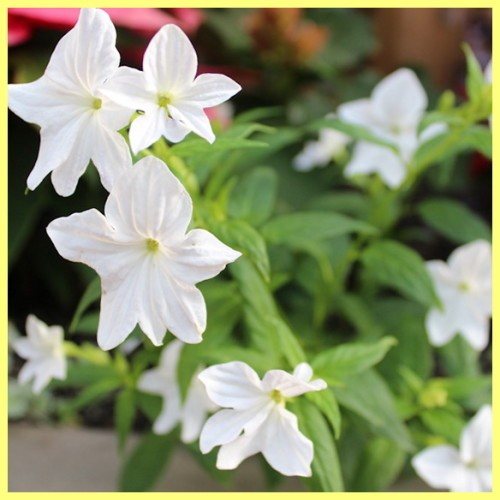

Brovallia 'Jingle Bells' has inflorescences in all shades of blue. If you want rich colors, you can plant the 'Blue Bells' variety, its dark blue flowers will perfectly fit into the atmosphere of your home or apartment.
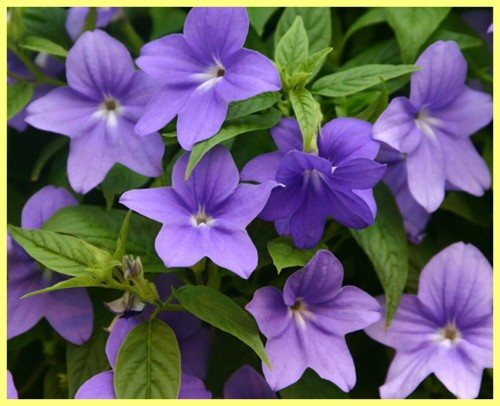

Brovallia Browallia demissa is not as popular as other varieties, but it is not inferior to them in attractiveness. It can bloom with inflorescences of white, purple or blue. The plant grows up to 70 centimeters in height, usually in greenhouses or conservatories. On the windowsill, the flower barely reaches 40 centimeters in length.
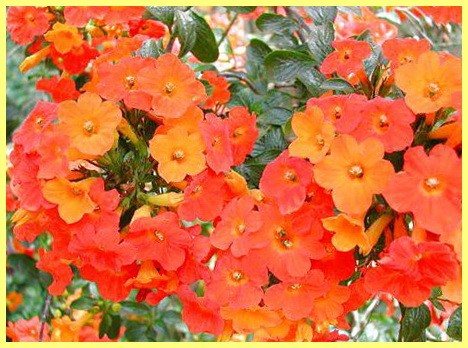

Another wonderful plant variety Browallia viscosa, popularly called the flower Brovalia sticky.The plant got this name because of the sticky substance that the leaves secrete. The shrub blooms in early November and the flowering period lasts until the end of winter. During this period, the plant is abundantly strewn with small flowers of purple and blue shades.
It is of interest that the care for all varieties of a flower is approximately the same. You can plant any kind of these plants at home, and it will delight you with its flowering.
Description of the plant


This herbaceous flowering plant at home, the plant reaches a meter in height and is considered a semi-shrub. Garden forms are half as low, indoor are bushes with soft drooping shoots.
The stems of the plant are densely "covered" with axillary single flowers, resembling asterisks. The corolla of the flower is formed by five half-fused petals of a funnel-shaped shape and is colored in various tones: from snow-white to blue and purple. The flowers are bisexual, odorless. Flowering lasts from spring to frost.
The fruit is a capsule with a lid and shutters. Small dark seeds ripen in it, pouring out through the valves. Seeds of the first year have a high germination capacity.
Tall species are grown outdoors for decorative purposes and for cutting. Low-growing - for decorating loggias and balconies, like houseplants. To enhance the decorative effect, garden varieties of brovallia are placed in a group; when grown in pots, several bushes are planted together in one container.
Home care
Brovallia is quite simple and unpretentious to care for.
The main task of leaving is actually reduced to the removal of dried foliage and faded flowers.
Shoots can be pinched from time to time to form a bush and give the plant branching.
The composition of the soil is absolutely not demanding, the main thing is that the soil is of high quality and well-drained.
It is important to take precautions when working with a plant, as the plant is poisonous. It is necessary to work with gloves and then wash your hands thoroughly.
Creation of favorable conditions
Illumination and temperature
Brovallia prefers bright places for growth and development, tolerates partial shade well. The ideal option would be east or west windows.
Brovallia does not like too high temperatures; in summer, the optimal comfortable temperature for it is 20 degrees, and in winter, 10-15 degrees.
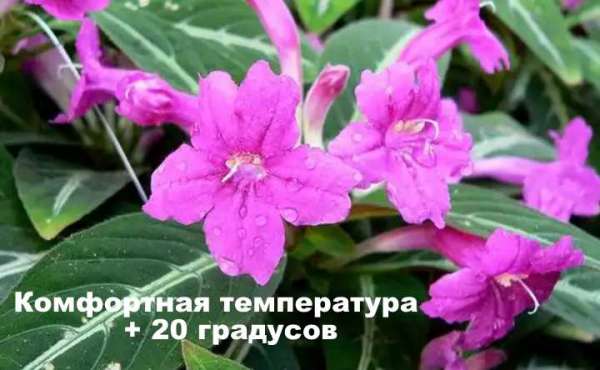

In summer, watering should be plentiful, and during winter, watering should be stopped altogether.
The main task of irrigation is to maintain soil moisture, preventing waterlogging. In dry weather or too dry indoor air, the plant can be carefully sprayed without getting water on the flowers of the plant.
It is necessary to fertilize plants in pots and containers only during the flowering period 2 times a month with universal fertilizers, reducing the recommended rate by half. Plants in the open field do not need feeding.
One of the essential elements of brovallia care. Due to pruning, it is possible to maintain the decorative effect of the plant.
In addition to shortening and pinching elongated shoots, it is important to remove faded flowers and wilted leaves in a timely manner.
Reproduction
Since brovallia is an annual plant, after flowering it gradually dies off. A new plant can be grown from its cuttings or its seeds.
It is better to pick up the soil for a new plant from sand and humus.
Plants can be propagated by cuttings or seeds at any time of the year. Only the flowering period of the plant depends on the time of sowing the seeds.
If you want your plant to bloom in the house as early as possible, then the seeds should be sown in August, and if you want to plant it in open ground, then in February. The seeds themselves do not need to be buried; they need light for germination.
Further, the planting should be sprayed daily with warm water. It is better to cover the container with seeds with foil or glass to create the effect of a greenhouse, and place it in a lighted place.
Every day, the greenhouse needs to be ventilated in the morning for a couple of hours. The first seedlings appear within a week. After germination and rooting, young shoots are planted in separate containers.
When warm weather outside the window is established, plants can be transplanted into open ground.
For propagation, cuttings can be taken from anywhere in the plant, while flowers must be removed from them.
You need to root in a light substrate, you can in sand or water, by organizing a greenhouse cuttings from a plastic bag. When roots appear, the plants are planted in separate containers.
Botanical description of the flower, its origin
Brovallia is an ornamental plant of the Solanaceae family. The genus unites 6 species of herbaceous perennials. It reaches a height of 20-25 cm, but some varieties can grow up to 100 cm. Homeland South America.
The name of the flower was given by Karl Linnaeus in honor of his friend the bishop, physician and botanist Johannes Brovall. For the first time, the plant got to Europe in 1846.
What it looks like: description and photo
Brovallia can be erect or creeping. Shoots are thin, slightly pubescent or bare, strongly branched. Leaves are short-petiolate, whole-edged, broad-lanceolate or lanceolate-heart-shaped with an elongated or pointed end. The leaf plate with veins, the surface is uneven. In length, the leaves reach from 2 to 8 cm, and in width - from 1 to 4 cm.
Flowers are axillary, solitary or collected in racemose inflorescences. The corolla consists of 5 petals. The color varies from white to deep purple. The flowers are self-pollinated, odorless, appear from early spring to late autumn. Fruits are small, oblong, dark. There are 10–45 seeds in a box.
Below are photos of the plant.
Other names
Brovallia is also called:
- colchicum;
- colchicum;
- amethyst flower;
- sapphire flower;
- shrub violet.
The names come from the appearance of the plant, its five-petal flowers of various shades are similar to violet flowers.
Using
Due to its spectacular and long-lasting flowering, beautiful brovallia is used to decorate interiors, balconies and closed terraces.
Well-groomed indoor plants can be a real decoration of the house. Such flowers not only give home comfort and habitability, they also benefit all family members. Houseplants are able to purify the air from various aggressive impurities, ranging from carbon dioxide and ending with viruses and bacteria. Many crops are now on sale that are suitable for growing on a windowsill. And one of the attractive, but not very well-known plants is the beautiful brovallia flower, we will discuss its cultivation at home from seeds in a little more detail.
The beautiful brovallia is cultivated as an annual plant. It is grown both in the garden (like petunias) and indoors (in an ordinary apartment). At home, such a plant is capable of forming a medium-sized lush bush, the height of which does not exceed forty centimeters. Many star flowers appear on it, painted in white or violet-blue tones of various saturations. Such flowers look very advantageous against the background of bright green leaves. A distinctive feature of brovallia is the ability to bloom profusely throughout the growing season, even with a lack of lighting.
How to grow brovallia from seeds at home
?
Sowing brovallia seeds can be carried out at different times of the year. So, if you want to admire the attractive flowering in summer, for example, on the balcony or on the terrace, it is worth sowing in late February - early March. And when planting seeds at the end of summer, the beginning of flowering will come in December-January. In the event that sowing is carried out at different times, you can achieve almost year-round flowering.
For sowing seeds, you need to prepare a container of a suitable size and fill it with moistened peaty soil.Seeds of beautiful brovallia must be distributed over the surface of the soil at a sufficiently large interval. They do not need to be covered with earth, since successful germination is possible only when exposed to light.
The container with seeds must be covered with glass or plastic wrap. Such a simple manipulation will create a greenhouse effect. Landings must be placed in a sufficiently illuminated place.
Every day it is necessary to spray the soil with crops using a spray bottle. Also, every day, readers of Popular About Health need to remove the shelter from the box for one to two hours for airing. The optimum temperature for germinating brovallia seeds is considered to be twenty to twenty-five degrees. Subject to all growing conditions, the first seedlings are observed literally after a week and a half.
After the emergence of seedlings, the shelter must be gradually removed. And after the young plants grow up a little, and a couple of real leaves appear on them, they should be dived - transferred to separate containers. Experienced flower growers advise placing two or three seedlings at once in each pot so that the flowering is very abundant. After diving, young plants should be pinned - this will add splendor and abundance of flowering to them in the future.
Features of further growing beautiful brovallia at home
Such a plant is not very capricious. It prefers to grow in moderate to cool temperatures. If the thermometer in the room rises above twenty-five degrees, the leaves begin to quickly turn yellow and dry out. Also, the number of buds and flowers that form decreases, and the plants themselves become abnormally elongated. Therefore, experienced gardeners are advised to grow brovallia on the windowsills of the eastern, western or northern windows (or on the same balconies).
Lighting features
Sufficiently bright, but diffused lighting is important for brovallia. Exposure to direct sunlight should be extremely minimal. Therefore, in the hot hours of the day, it is worth shading such a pet with a tulle curtain or a sheet of paper attached to the glass.
Watering features
At the stage of active vegetation, the plant needs systematic and fairly abundant watering. It is carried out after the soil dries up a little from above. But the soil must constantly remain moist inside. Moisture deficiency can kill the plant.
At home, beautiful brovallia needs periodic spraying, especially in very dry and hot periods. Such moisturizing will only benefit her.
Transfer
The plant is renewed every year. It is convenient to do this by pruning and re-rooting of the apical shoots. So, young rooted cuttings are transferred into the soil, consisting of equal shares of sod, leaf and humus soil, as well as sand. Store soil, for example, for petunias, is also a good option.
Top dressing
A few months after planting, potash fertilizers or special mixtures for flowering crops, for example, lux fertika, can be applied under the plants. Such measures will help increase the flowering intensity, but they are completely optional.
Additional Information
In order to achieve the longest possible flowering of brovallia, it is imperative to eliminate faded inflorescences.
Such a plant is quite resistant to disease, however, it can suffer from an attack by a spider mite, whitefly or scale insect. Spraying with insecticides will help to cope with them.
With insufficient proper care, brovallias can become ill with powdery mildew, which requires the destruction of unhealthy plants and the treatment of the remaining fungicides.
Brovalia is a great nightshade plant that can complement your home plant collection.Although the eyebrow is related to potatoes, the plant looks more aesthetically pleasing and has interesting flowers, which, by the way, grow for a whole year, which certainly pleases the owners of the eyebrow.
The plant itself does not require light, which makes it an ideal flower for a short winter day. What you should pay attention to is that the eyebrow does not tolerate low temperatures and drafts. This, perhaps, is her only weakness, given the general unpretentiousness in the conditions. For long-lasting flowering, remove wilted and dried parts of the plant during flowering. Despite the fact that the brovalia is considered a perennial, the plant ages over time, which is expressed in thinning of the leaves and in more meager flowering. Therefore, many growers prefer to grow it as an annual.
Advice: "To make the eyebrow delight you with abundant flowering for a long time - regularly cut off the dried color."


